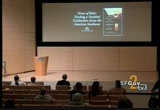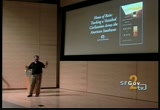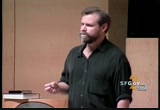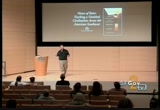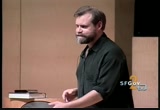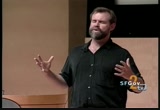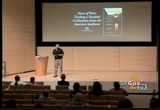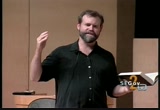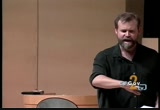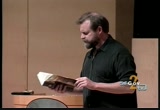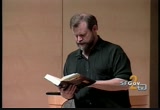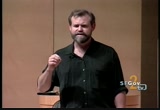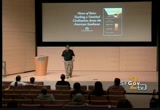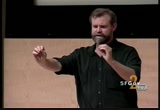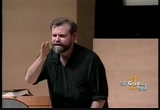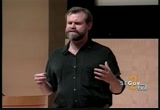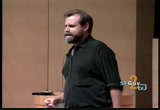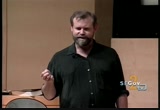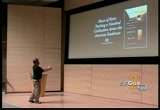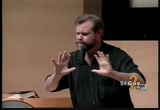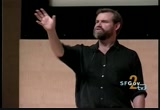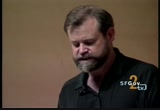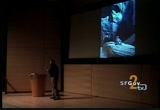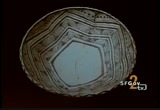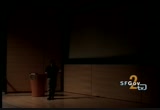tv [untitled] July 20, 2012 3:00am-3:30am PDT
3:00 am
childs. . >> hello. i come to you from out of the desert. i'm coming to you from a landscape where once you get an eye for things, 3 grains of sand out of place draw your attention, where everything is brought to bear, where everything is hinged to a story, every drop of rain leaving a dimple in the ground. stories are everywhere out in this landscape. when you walk down into the bottom of the narrow canyons made of sandstone and you put your hands on the sand stone faces and the smooth shallow
3:01 am
scallops that look like champagne glasses, you can feel the shape of the last flood that came through. every place in the desert is a story. every place is a passage way. it's really hard to walk very far in the desert for me because there are so many stories that start opening up and lead you from place to place and place and soon you start picking up the patterns of wind, of rain. you pick up the patterns of people who were there before you because, out there, things seem to last forever. if you put a footprint down in certain places, that footprint will stay for 5 years, maybe even 10 years for somebody who's got a really good eye where you come walking along and you see the slightest depression in the ground and you kneel at it and you figure out that it was a person with about a size 9 foot walking across the desert 8 years
3:02 am
before you. everything out there tells a story. that's why i'm here. because i'm looking for stories. i'm looking for these same kinds of stories that i find in the desert. i came to hear straight from grace cathedral today where i walked into the cathedral and i took off my shoes and walked on the maze that's right in the front, in the center. and i don't know if you've ever been to this place. you have to stop in and walk this maze because it is very much like what it's like to be out in the desert. where you start walking along and you see where you are going eventually. you see the center spot and you know where you are going to be, except you are going away from it and then toward it and then away from it and all the way around it and then away from it again and back toward it.
3:03 am
that's what it's like walking out in the desert in the deep cliffs, in the dunes where you want to go there but there's not a route from here to there. if you had a gps it wouldn't really work because it would point a straight line from here to there because there's a cliff face and to get down you have to go down a series of ledges and to get up you have to go down a narrow canyon where there's a big boulder jammed into the bottom. every place has this backward trail, this labyrinth, leading you around. i was walking arpd this maze for about an hour before coming here and it does the same kind of thing where your mind settles, where you have to pay attention to where you are going. because if you look up for too long at all the passing architecture, you will forget where you are on the maze. you will end up in the wrong spot.
3:04 am
you will end up going the wrong direction and you won't be able to find your way to the center. of course, out in the desert, you can't just walk off of the maze and out the front door and back into the street. out in the desert, you are there. the cliffs stand around you. the mazes are everywhere, passages opening up left and right. to write this book, house of rain, i walked a little bit over a thousand miles in legs from the four corners region from arizona, new mexico, colorado and california meet down to the chijuajua area of new mexico. there was one excavation along
3:05 am
the way i remember out in the desert nears winslow, arizona. the desert out there is just a still life with a few landmarks on the horizon and this empty hole, the little colorado river desert, the painted desert, and we were working on a 500-room pueblo dating back to about 1400 ad. i just remember the wind just hailing down on us for days and you would be working down with trowels inside of a trench and if you stop for too long, the sand would start to fill up your hole again because it was blowing so much and everybody was turned away from the wind. so it looked like some kind of religious thing was going on here, all these people bowed to the ground for days and days tinkering with some unimaginable smallness in front of them while the wind just pushed harder and harder, sand blasting across you, filling up all the rooms that you just
3:06 am
emptied out as if the desert is rolling back over itself. because even where trails are left, trails disappear out there. nothing stays for too long, even the footprints that last for 7 years eventually disappear. i found something out there that i'd like to read to you. it was a site, an archeological site on the colorado plateau, that i ran into a number of years ago. and i've gone down to it a couple of times now. when i first found it, i had been on the river for 7 days in a canoe. and i tied off and broke through the tamarisk which if you've ever been down on those
3:07 am
desert rivers, the tamarisk, the invasive species of plant that runs along the shore line, it makes this jungle, this dry, hard jungle that you just work your way through until you have sticks stabbed into your ears and hair and tamis buds is what they call it, it's the stuff that rains down off these trees and it fills up the back of your shirt. i came up to this flat area and this cliff was there and i saw a piece of pottery on the ground, a broken piece of pottery. if you start looking around, you see broken pieces of pottery that date back 800 years, 900, 1200 years, and i dropped down on my hands and knees when i saw that one and i started brushing away sand until i could see others and i blew the sand away and i could see the rim of a broken pot. once i saw that, my eye was
3:08 am
much sharper and i could see the details around me. i could see a small community, a family of maybe 12 had lived here. when i looked up into the cliff, i saw stacks of rock behind a little spall of the cliff that had stuck out and i realized there was a granary up there. i immediately started for it, climbing hand over hand up the cliff base. my breath tasted hot with discovery. i had found a secret. in past travels i had seen many granaries belonging to the anastasi but they had all been broken open by pot hunters or even by the residents
3:09 am
themselves. this one had been built so no one would see it, like an attic accessed through a hidden floor. the structure was rectangular, like a cupboard. i touched its face with probing, diagnostic fingers, measuring it my eyes. 3 feet tall, 2 feet wide and 3 feet deep. i got up on my haunches and lightly dusted off the granaries roof which was undamaged. for 3,000 years not a breeze had entered this chamber, not an inkling of light. what tightly woven baskets were here, what woven textiles, what stockpile of cobalt blue and honey-colored seed corn left many years before the boom of
3:10 am
spanish rifles. with my fingers i traced through the dust of fallen rock debris on the granary roof. when i'm out there looking for stories and routes and trails, i find things like this. i have so far come upon 3 baskets in the desert and 3 different whole ceramic vessels that people had put underneath ledges and these are things that i don't dig for, i just look in cracks and crannies to see what's left behind. you find pieces of sandals or sometimes whole sandals. you find little bits of people, signs that in this desert,
3:11 am
there were people everywhere and they aren't always small like that. they aren't always a ceramic vessel under a ledge. sometimes they are huge. sometimes they are 3-story dwellings built up into the cracks. they are buildings that they made in the 11th century ad, that the anastasi, the pueblo people made, that a base 5 stories tall. they built at least 400 miles of roads are documented in the four corners area. when i'm saying roads, i'm saying swaugts cut across the desert that are 30 feet wide that have berms about this high on both sides and run absolutely straight. and if they hit a landmark of some sort, they don't around it, they go up and over it or they go down a cliff and when
3:12 am
you are on one of these roads and you get to the edge of a cliff, you can see that it's easier to go down maybe 20 feet over to your left, but they go right down the cliff. and you look down the cliff and there are stairs carved into the cliff face so that this road stays absolutely straight. my take on this is that out in the desert, the ultimate commodity besides water is visibility. and if you set a line across the desert, you are going to see it from everywhere. every butte top, you are going it look down on this desert and see these bold lines coming across the desert and you know that line goes somewhere. you get on it, you stay on it, and it will lead you to what are called great houses, up it 3 acres in size. these great houses are often aligned in a certain way so
3:13 am
that at certain times of year, say summer solstice, light comes through certain windows. i have sat in these at different times of the year and watched this light show start at sunrise where lights start appearing on the walls all around me and you realize this is how you tell time out in this landscape. this is the way they did calendars. this is the way they understood the larger sphere, the moving of the heavens, was by setting up structures that could receive the light in certain ways. i mean, it's happening everywhere. i was just in salt lake city and i took a walk downtown and i saw a pillar that had been built in the last 4 years that a big block of sandstone that i recognized. it was probably wingate sandstone that had been hauled up there from about 200, 250 miles away, but i noticed in the pillar that was a gap at the bottom and i walked up and
3:14 am
looked through the gap and i saw there were some posts in the distance and i looked around and there was a circle around the gap and there were signs around it and then each post a prism in it so that light going through the crack would hit the prism and that light would go to another prism and you would be able to tell the time of year by this object that was built in the last 4 years. and i saw this and i thought, what would archeologists think if they encountered this? they would look at this and say, what civilization was this? what religion drove them to do this? we keep doing the same things over and over again. many researchers believe these archeo-astronomical sites are very specifically designed where other researchers say it's all coincidence. but not long ago i was up at a place called chimney rock in southwest colorado.
3:15 am
and it's over 8,000 feet. and you are up at the southern end ftd rocky mountains and there is this scarp of rock that rises up probably about a thousand feet out of a valley floor and right at the tip of this scarp there are two twin towers of rock. if you get to a certain place on top of this very narrow butte, you can see between these twin towers and there happens to be a great house built between these two towers and every 18.6 years when the moon goes into its northernmost point on the horizon, it rises between those two towers. i was there at the beginning of the last 18.6 year cycle and we stood up there, probably 20 of us, researchers, forest service people, all gathered at the
3:16 am
same spot with cameras and huddled -- it was late december at 8,000 feet and we were all watching this gap. and somebody had done very intricate work to figure out exactly where you need to stand to see the light at exactly the right time. and as we were all gathered up there, i remember this older archeo-astronomer said it's too bad this isn't celebrated any more. this is such a momentous occasion, the moon finally coming up between the gap and nobody celebrates it. i looked at him as we were all bundled together and thought, do you not notice all of us here pressed to the edge watching this one gap just to see a breach of light come through the spot? if this isn't celebrating this moment, i don't know what is, a bunch of researchers coming from all over the country, in fact, all over the world for this event. this is probably what happened a thousand years ago. i imagined a man very much like the one who had figured out
3:17 am
where we needed to stand at what time, or perhaps it was a woman, it was someone who came up and checked this site every day until he sent out the word saying, okay, on this particular day you can put on your feathers and everybody get your stuff, we're going up and it's going to happen. because as the moon was rising i could see he was nervous, pacing back and forth because he wasn't sure if he was exactly right. you use spherical trigonometry to figure it out and he was pacing back and forth and i could see he was going through his numbers going, okay, a lot of people came for this, am i right about this? and i thought about these fierce-looking mayan dudes who
3:18 am
came out of chaco and the great house, the tree rings taken out of it, show it was constructed every 18.6 years. every time the moon came through the gab, they did massive construction for it. so you know it was the time and you know there was somebody pacing up there just checking whatever watch he had, looking at that gap and thinking, i hope this is the day. and it was the day. we stood there and waited and he said first light, we all looked and we couldn't see it. he had a better eye, he had been watching this much longer than us. but then we started to see the glow. and then the orb of the moon rose into this narrow gap between two twin towers looking north into the rocky mountains. and as that happened, i turned around and as the south -- and i see out of the rocky mountains, i could see a gap where the piedro river flows
3:19 am
south and through that gap i could see the desert of northern new mexico and just over the horizon, just about 120 miles away, is chaco canyon, the largest anastazi site in the southwest, just over the horizon. and in between these towers and chaco canyon there are fire signal stations up on top of buttes. every fire signal station is in view of two other signal stations. each of those, four, on and on and on so that a fire would be lit at one spot and everybody would know, you could send messages for hundreds of miles. you could send messages over mountain ranges. there are fire signals all over the four corners, rows and fire signals. i talked to the guy who first discovered these signals and he was just out there mapping archeological sites with a crew in the 70's and he kept coming across these hills that had
3:20 am
some kind of -- a little bit of architecture but they couldn't tell what they were. and they decided they are just not going to put them in the reports because they didn't have a name for these until he decided to go up to one and he dug into it and there he found a carved stone bowl with a carved stone lid set into it. and he opened it up and it was full of pieces of turquoise and that's when he looked around and thought, wait a minute, there's something going on around here. he started mapping them all, he started marking them all on his map until he realized, these are all visual relays. there's a network, a communication network, of some sort. or maybe it was when the moon reached the gap they lit the fire so the signal went out so everybody across the colorado plateau would know the needle has been threaded. and i imagine that day people in chaco canyon all standing
3:21 am
there, facing north, looking at a fire tower that would have delivered a message down into the canyon. i imagined people all over the four corners all facing the same direction at the same moment, maybe this didn't happen. everything is conjecture out there, but you know something was going on. how much do you want to know? when i saw that granary up in the cliff, i wanted to know what was inside of it. i thought i could easily break the seal around this stone. i had a good knife with me. it would be very easy to cut a square around it and just pop that stone out and i would see what's inside of a granary, what these people left behind. it was something for their survival, something that they could return to, something very important. i spent years going through
3:22 am
museum collections and opening up drawers in the basement of the peabody and the american museum of natural history where you are going through masses of artifacts, the striking black on white pottery of the anastazi, what is in this place? but the granary was not mine to open, it was left by other people, a stockpile waiting for their return. as i understand more of the anastazi, it is hard to say they ever truly vanished. the more i track them, it more it seems they are right in front of me until i can feel body heat in their foot steps. it is not unthinkable that somebody might return to this granary, maybe a century from now, relieved to find a sign of ancestry deep in this river gorge. i climbed down to this granary
3:23 am
and laid my hand on its stone, feeling the grit of sand and the hardness of rock. a person could be found here in a thousand years, a person kneeling in the moment of decision. i climbed out and went back to my career, the obsidian night closing around me. i climbed into the canoe and swept the paddle across the water, setting a wake across the mirror of stars. i'd like to show you some images from this place. this place being the southwest where i have spent my entire life. i don't know how far i've walked out there. i don't know how many pairs of boots that i've gone through where i've taken needles and dental floss and sewed the leather back together.
3:24 am
i don't know how long i've been walking out there. and miles don't matter, days don't matter. it all adds up into this, into movement, into walking through the labyrinth that's opened up into the ground. finding places, places to camp behind cliffs that have fallen, finding sanctuary, places where the wind won't touch you, places that are eroded out of the earth like bones. everything is revealed in the desert. there are no questions out there. there's just ground, solid ground, opened layer after layer after layer. some people come back from, say, the edge of the grand canyon and they say it makes them feel small.
3:25 am
i understand that but i think it may be a misconception. it may be that it's not a landscape that makes you feel small, it's a landscape that gets rid of your sense of scale entirely because there have been so many times out there in the deep of winter camping for week after week in the open desert where at night it gets down to 10 below or 15 below zero and there's nothing in your life but the sky and the stars. and you are looking up into the sky and you think, i could just stand and walk into stars. i could become a giant. there are times in the desert when you are not small but you are infinite. you take up everything. there is no boundary between you and it. when i look at the artifacts that the anastazi made, especially the painted black and white, i see that landscape. i see the colorado plateau.
3:26 am
this bowl is from american museum of natural history and that's where it is now. that's the storage place. where it was from before is pueblo bonito in chaco canyon where there were rooms filled to the ceiling with bowls stacked within each other, bowls like this. all their designs, you can kind of get a glimpse around this. they have this flawless symmetry blending all the way around. it looks like that place. it looks like that landscape. i look into this and i see the sharp edges of the land. i see the way the earth is shaped out there. i see the routes in their vessels. i mean, to understand these, this one came out of a 13th
3:27 am
century site in southwest colorado and i would sit with these bowls for hours and hours, drawing them into my sketch book because that was the only way i could really understand the complexity of how they got their symmetries to match up because i could never get them to match up in my drawings. i could never do a 100 percent accurate rendition of these because every line was meaningful, every line meant something about how you paint the next line, which is what it's like walking out there, looking for those shapes, looking for water, looking for springs, looking for places where the rain has fallen. it's all the same story out there. there is a 13th century or a 14th century polychrome vessel from below the mugion rim in central arizona. and this is 100 years after the
3:28 am
anastazi supposedly disappeared, there's that story about one day this whole civilization just vanished. but if you start following the civilization, you can find where it went. you can find this culture's movement across the land. these images inside this bowl came from vessels that were anastazi. and you can track the movement of styles across the southwest, across centuries. and i look into these and i see people from the high desert living down in the pines of central arizona. i see the shapes of their lives still recorded, that the anastazi didn't disappear, they just moved and they carried everything with them. and when they ran into other cultures, they adjusted. they changed the colors of their vessels but they kept the same images, images of a landscape that is worn open, that is controlled by basic
3:29 am
elements, by wind, by water, by gravity. see the shape of the world where i have spent my life, where i have been walking, looking for these stories. and just to give you a sense of scale here, that's me at the bottom of that pillar. and that pillar is just some old wall and that's all that's left of it, some memory of a canyon. every place out there is a memory, a memory of water, a memory of humans. most of those vessels that i just showed you -- they all came from museums. here is one that i found a few years ago, a seed jar in utah underneath a ledge. and i didn't move it from the spot. in fact, the sand had just been barely swept away to
64 Views
IN COLLECTIONS
SFGTV2: San Francisco Government Television Television Archive
Television Archive  Television Archive News Search Service
Television Archive News Search Service 
Uploaded by TV Archive on

 Live Music Archive
Live Music Archive Librivox Free Audio
Librivox Free Audio Metropolitan Museum
Metropolitan Museum Cleveland Museum of Art
Cleveland Museum of Art Internet Arcade
Internet Arcade Console Living Room
Console Living Room Books to Borrow
Books to Borrow Open Library
Open Library TV News
TV News Understanding 9/11
Understanding 9/11